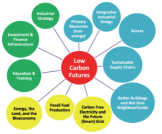The current menu of climate change mitigation policies focuses on improving the utilization efficiency and reducing the carbon content of fuel and electricity. Carbon pricing, efficiency regulations, feed-in tariffs, renewable electricity and biofuel mandates, public investment in efficiency and carbon- free alternatives, consumer education and social marketing – these are the elements we find in climate change response policies around the world. They have worked, but not well enough to bend the curve of growing emissions to the extent needed to avoid dangerous climate change. They will give us futures in which emissions are lower than they would otherwise be, but they will not lead to low-carbon futures in the context of avoiding dangerous climate change.

